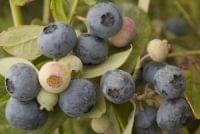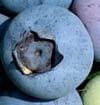We sell our products to retail nurseries, garden centers, container growers who sell to landscape contractors and retail nurseries, mail order nurseries, and anyone else who qualifies. We do not accept direct sales to consumers.

Now it's easy to grow your own!
Check out the new low-chill varieties of blueberries and take advantage of the great new ideas on how to grow them!
In recent years there has been a parade of new introductions coming out of the southern states. These more adaptable varieties are called Southern Highbush blueberries and meet most of the requirements for growing in the western climates.

These great-flavored varieties are well adapted to the low-chill West and have a high summer heat tolerance.
An excellent blueberry to plant this season is the Southmoon, an early-bearing, fine-tasting blueberry which was the only one in a local collection of 20 varieties that didn’t show leaf burn in the (hot!) California summer. Because it’s early, Southmoon is the perfect complement to a mid- or late-season variety.
The O'Neal was one of the first Southern Highbush types introduced in California for home gardeners and it still is a first choice with a fine quality berry. Other new varieties to look for include Sharpblue, Sunshine Blue and Misty.
Remember: Blueberries yield much bigger crops when paired with another variety. There is such a great selection of adapted-to-low-chill varieties, that it's possible to avoid the Northern Highbush varieties completely unless you are sure you have the climate conditions to suit them.
To make growing blueberries easier, do NOT plant them in the ground!!
Blueberries make a wonderful container plant.
Container-grown blueberries are ornamental as well as productive.
Blueberries like a low PH of 4.5 to 6.0, with 5.5 being optimal, and they like to grow in actively decomposing organic matter.
Soil sulfur needed to achieve 4.5 pH (in teaspoons per cubic foot of soil mix):
pH____Sand____Loam____Clay
5.0_____0.5______1.5______2.3
5.5_____1.0______3.0______4.5
6.0_____1.4______4.3______6.5
6.5_____1.8______5.6______8.4
7.0_____2.5______7.5_____11.3
Here is a here is a blueberry potting mix that has been very successful:
1/3 pathway bark (1/4 inch)
1/3 peat moss (coarse, if you can find it)
1/3 leaf mold or forest humus based potting soil
Mix together and add 2 tablespoons of soil sulfur
 This mix will get your container blueberries off to a great start. Then, in then spring, use a fertilizer high in nitrogen (sulfate or urea) and minor nutrients.
This mix will get your container blueberries off to a great start. Then, in then spring, use a fertilizer high in nitrogen (sulfate or urea) and minor nutrients.
Check carefully when selecting fertilizers: the nitrogen must not be from nitrate, which can be deadly to blueberries (don't find out the hard way!).
With the new introductions, you can have ripe blueberries in your yard from May to August!

Best of Health to You!
